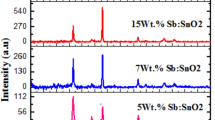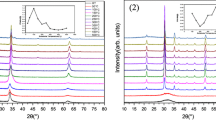Abstract
A suitable combination of window and absorber layers plays a vital role in the fabrication of an efficient solar cell system. Here, we report the investigations concerning tin antimony sulfide, SnSb4S7 (TAS) thin film as an n-type window layer, prepared on the cleaned glass substrate via thermal evaporation technique. The obtained 150 nm thin films were annealed at 150, 200, 250, and 300 °C in an argon atmosphere, and then analyzed to get insight about its potential in a solar cell as an n-type window layer. The resistance of the films, determined via Van der Pauw technique, is found to be decreased (76–52 MΩ) with increasing annealing temperature. XRD analysis showed that the calculated crystallite size of the sample annealed at 300 °C was around 16 ± 0.5 nm, which is consistent with the characteristic range of window layer. Moreover, the calculated band gap (2.3–2.85 eV), low absorbance, and high transmittance values in the visible range also endorse the potential of TAS thin film for window layer.







Similar content being viewed by others
References
M. Warasawa, A. Kaijo, M. Sugiyama, Advantages of using amorphous indium zinc oxide films for window layer in Cu(In,Ga)Se2 solar cells. Thin Solid Films 520(6), 2119–2122 (2012)
H. Moualkia, G. Rekhila, M. Izerrouken, A. Mahdjoub, M. Trari, Influence of the film thickness on the photovoltaic properties of chemically deposited CdS thin films: application to the photodegradation of orange II. Mater. Sci. Semicond. Process 21(0), 186–193 (2014)
G. Kartopu et al., Effect of window layer composition in Cd1–xZnxS/CdTe solar cells. Prog. Photovolt. Res. Appl. 22(1), 18–23 (2014)
H.J. Lee, S.U. Kim, S.J. So, Y.D. Cho, Y.J. Kim, S.C. Ahn et al., Reduction of surface defects on the GaP window layer of 630 nm AlGaInP LED using post-Zn diffusion process. Curr. Appl. Phys. 13(6), 1032–1036 (2013)
N. Naghavi, G. Renou, V. Bockelee, F. Donsanti, P. Genevee, M. Jubault et al., Chemical deposition methods for Cd-free buffer layers in CI(G)S solar cells: role of window layers. Thin Solid Films 519(21), 7600–7605 (2011)
J.N. Alexander, S. Higashiya, D. Caskey Jr., H. Efstathiadis, P. Haldar, Deposition and characterization of cadmium sulfide (CdS) by chemical bath deposition using an alternative chemistry cadmium precursor. Sol. Energy Mater. Sol. Cells 125(0), 47–53 (2014)
S.R. Kodigala, 7 - Fabrication and properties of window layers for thin film solar cells. In Thin Films and Nanostructures, ed. by K Subba Ramaiah (Academic Press, Cambridge, 2010), p. 393–504
S. Lugo-Loredo, Y. Peña-Méndez, M. Calixto-Rodriguez, S. Messina-Fernández, A. Alvarez-Gallegos, A. Vázquez-Dimas et al., Indium sulfide thin films as window layer in chemically deposited solar cells. Thin Solid Films 550(0), 110–113 (2014)
S.R. Kodigala, Chapter 1 - Introduction. In Thin Films and Nanostructures ed. by K Subba Ramaiah (Academic Press, Cambridge, 2010), p. 1–19
Z. Yu, I. Pereyra, MNP Carreno, Wide optical band gap window layers for solar cells. Sol. Energy Mater. Sol. Cells 66(1–4), 155–162 (2001)
C.M. McShane, W.P. Siripala, K. Choi, J. Phys. Chem. Lett. 1, 2666–2670 (2010)
A. Safdar, M. Islam, I. Ahmad, A. Akram, M. Mujahid, Y. Khalid, Y. Zhu, Mater Sci Semiconduct Process 41, 420–427 (2016).
N. Ali et al., Advances in nanostructured thin film materials for solar cell applications. Renewable Sustainable Energy Rev. 59, 726–737 (2016)
N. Ali, S. Hussain, M. Iqbal, Z. Iqbal, D. Lane, Metal based chalcogenide thin films for photovoltaics. Chalcogenide Letters 9(11), 435–440 (2012)
N. Ali, S.T. Hussain, Y. Khan, N. Ahmad, M.A. Iqbal, S.M. Abbas, Effect of air annealing on the band gap and optical properties of SnSb2S4 thin films for solar cell application. Mater. Lett. 100(0), 148–151 (2013)
N. Ali et al., A novel approach for the synthesis of tin antimony sulphide thin films for photovoltaic application. Sol. Energy 113, 25–33 (2015)
N. Ali et al., Effect of air annealing on the band gap and optical properties of SnSb2S4 thin films for solar cell application. Mater. Lett. 100(0), 148–151 (2013)
A. Jebali, N. Khemiri, M. Kanzari, J. Alloys Compd. 673, 38–46 (2016)
N. Ali et al., Physical properties of the absorber layer Sn2Sb2S5 thin films for photovoltaics. Curr. Nanosci. 9(1), 149–152 (2013)
N. Ali et al., Antimony sulphide, an absorber layer for solar cell application. Appl. Phys. A 122(1), 1–7 (2015)
R.A. Joshi, V.S. Taur, R. Sharma, Growth and characterization of nanostructured CdS/Polyaniline/CuInSe2 thin films for solar cell applications. J. Non-Cryst. Solids 358(2), 188–195 (2012)
S. Lalitha et al., Characterization of CdTe thin film - dependence of structural and optical properties on temperature and thickness. Sol. Energy Mater. Sol. Cells 82(1–2), 187–199 (2004)
Chander, S. M.S. Dhaka, Influence of thickness on physical properties of vacuum evaporated polycrystalline CdTe thin films for solar cell applications. Phys. E 76, 52–59 ( 2016)
M. Dhanam, R.R. Prabhu, P.K. Manoj, Investigations on chemical bath deposited cadmium selenide thin films. Mater. Chem. Phys. 107(2–3), 289–296 (2008)
N.F. Mott, E.A. Davis, Electronic Processes in Non-crystalline Materials. (OUP, Oxford, 2012)
D. Abdelkader et al., Investigation on optical properties of SnxSbySz sulfosalts thin films. Mater. Sci. Semicond. Process. 21(0), 14–19 (2014)
Acknowledgements
The authors would like to thank University Teknologi Malaysia/Ministry of Education Malaysia for the financial support of this research work through Project Nos. Q.J130000.2526.12H46, R.J130000.7826.4F508, Post-Doctoral Fellowship Scheme under Project No. Py/2014/03074, and International Doctoral Fellowship 176–BIASISWAZAH UTM IDF, and the author (Naser M AbdEl-Salam) is thankful to the Deanship of Scientific Research at King Saud University for funding the work through the research group Project No. RGP-210.
Author information
Authors and Affiliations
Corresponding authors
Rights and permissions
About this article
Cite this article
Ali, N., Hussain, A., Ahmed, R. et al. Fabrication and characterization of 150 nm tin antimony sulfide thin films, a promising window layer material for homojunction solar cells. Appl. Phys. A 123, 282 (2017). https://doi.org/10.1007/s00339-017-0879-4
Received:
Accepted:
Published:
DOI: https://doi.org/10.1007/s00339-017-0879-4




